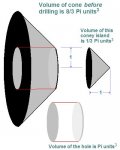I'm unsure of how to go about setting up these two problems:
1. Two identical cones with a height of 2 and a base circle of a radius of 2 are glued together at their bases and a cylindrical section of radius 1 is cut out along the axis of the resulting object. Set up and evaluate an integral(s) to determine the volume as a solid of revolution.
2. A dam is inclined at an angle of 30 degrees from the vertical and has the shape of an isoceles trapezoid 100 ft wide at the top and 50 ft wide at the bottom. It also contains a slant height of 70 ft. Find the fluid force on the dam when it is full of water. Weight density of water is 62.4 lbs/ft[sup:2h3eaw8w]3[/sup:2h3eaw8w].
1. Two identical cones with a height of 2 and a base circle of a radius of 2 are glued together at their bases and a cylindrical section of radius 1 is cut out along the axis of the resulting object. Set up and evaluate an integral(s) to determine the volume as a solid of revolution.
2. A dam is inclined at an angle of 30 degrees from the vertical and has the shape of an isoceles trapezoid 100 ft wide at the top and 50 ft wide at the bottom. It also contains a slant height of 70 ft. Find the fluid force on the dam when it is full of water. Weight density of water is 62.4 lbs/ft[sup:2h3eaw8w]3[/sup:2h3eaw8w].


